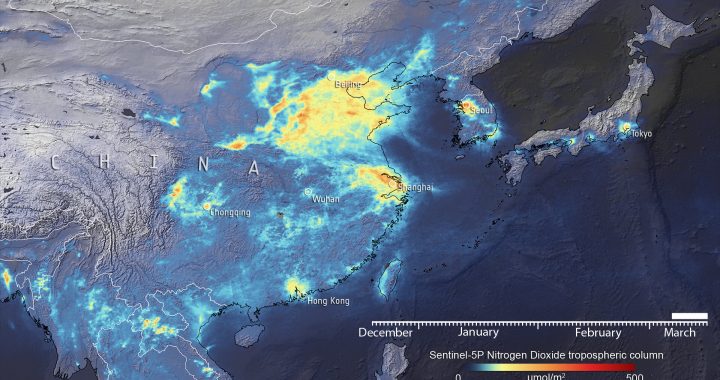Recent data have shown a decline of air pollution over northern Italy coinciding with its nationwide lockdown to prevent the spread of the coronavirus (COVID-19). This new map shows the variation of nitrogen dioxide concentrations over China from December to March – thanks to the Tropomi instrument on board the Copernicus Sentinel-5P satellite.
As news of the coronavirus broke out in the Hubei province, China, in late December 2019, stricter measures were put in place. As a result, by late January, factories were closed and streets were cleared as Chinese authorities had ceased daily activities to stop the spread of the illness.
This led to the dramatic reduction in nitrogen dioxide concentrations – those released by power plants, industrial facilities and vehicles – in all major Chinese cities between late-January and February. The drop in concentrations also coincided with Lunar New Year celebrations, which usually sees a similar drop in concentrations each year.
The Copernicus Atmosphere Monitoring Service (CAMS) observed a decrease of fine particulate matter – one of the most important air pollutants – in February 2020 compared to the previous three years. By combining satellite observations with detailed computer models of the atmosphere, their studies indicated a reduction of around 20-30% in surface particulate matter over large parts of China.
Access the video
As the coronavirus epidemic eases in China, many provinces have downgraded their emergency response levels. Schools, factories and other public spaces are starting to re-open and workers are gradually returning to their jobs.
This animation, using data from the Copernicus Sentinel-5P satellite, shows the nitrogen dioxide concentrations from 20 December 2019 until 16 March 2020 – using a 10-day moving average. The drop in concentrations in late-January is visible, coinciding with the nationwide quarantine, and from the beginning of March, the nitrogen dioxide levels have begun to increase.
Josef Aschbacher, ESA’s Director of Earth Observation Programmes, says, “Satellites offer a unique vantage point to monitor the health of our planet. Sentinel-5P is one of seven Copernicus satellites in orbit today. It currently provides the most accurate measurements of nitrogen dioxide and other trace gases from space.
“As nitrogen dioxide is primarily produced by traffic and factories, it is a first-level indicator of industrial activity worldwide. What is clearly visible is a significant reduction of nitrogen dioxide levels over China, caused by reduced activity due to COVID-19 restrictions, but also the Chinese New Year in January.”
He continues, “The Copernicus programme is a perfect example of how space serves all European citizens by combining the political strength of the EU with the technical excellence of ESA.”

Claus Zehner, ESA’s Copernicus Sentinel-5P mission manager, comments, “We can certainly attribute a part of the nitrogen dioxide concentration reduction to the impact of the coronavirus. We currently see around a 40% reduction over Chinese cities, however these are just rough estimates, as weather also has an impact on emissions.
“We are conducting a detailed scientific analysis which will soon provide more insights and quantified results in the following weeks and months.”
The Copernicus Sentinel-5 Precursor mission, also known as Sentinel-5P, is dedicated to monitoring air pollution by measuring a multitude of trace gases as well as aerosols – all of which affect the air we breathe.



